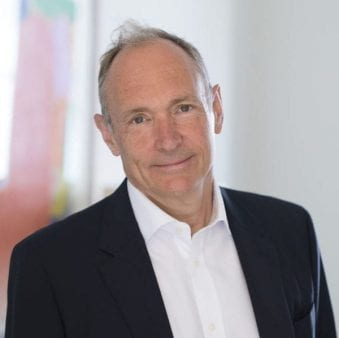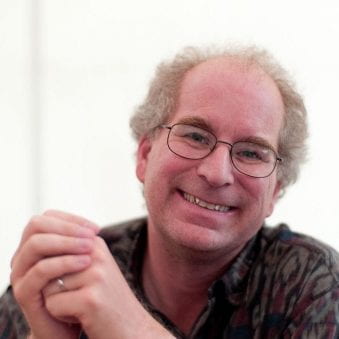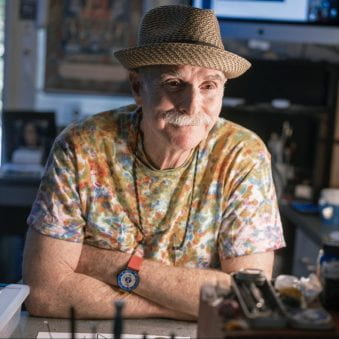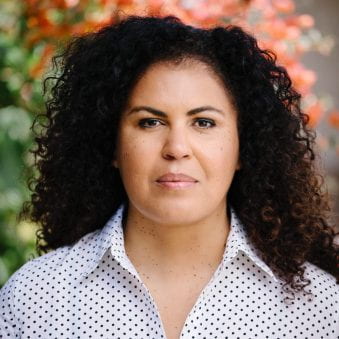Tim Berners-Lee: We have to realize that the people who run the social networks, the existing social networks, can change them. You know, they’re all just code. Maybe you’re a feminist blogger on Twitter or something. And you get up in the morning, and it’s hard to avoid people saying really nasty things about you. Then it’s reasonable to go to the platform. It’s reasonable to hold them accountable.
Noshir Contractor: Welcome to this episode of Untangling the Web, a podcast of the Web Science Trust. I am Noshir Contractor and I will be your host today. On this podcast, we bring in thought leaders to explore how the web is shaping society, and how society in turn is shaping the web. My guest today is Sir Tim Berners-Lee, who you just heard talking about how we can reengineer digital technologies for good. Tim is a computer scientist best known as the inventor of the World Wide Web.
But before I introduce Tim, an announcement: This is not only the 35th episode of Untangling the Web but the last one for this season. Keep your ears open on your favorite podcast platforms for a mini episode reflecting on the past, present and future of the Untangling the Web podcast series.
That said, let’s get back to Tim. Tim is a professorial fellow of computer science at the University of Oxford and a professor at the Massachusetts Institute of Technology. He is the director of the World Wide Web Consortium, W3C for short, which oversees the continued development of the web. He co-founded the World Wide Web Foundation and is the founder and president of the Open Data Institute. He is also the founder of the Web Science Trust, which produces the Untangling the Web podcast. In 2004, Sir Tim Berners-Lee was knighted by Queen Elizabeth for services to the global development of the Internet through his invention of the World Wide Web. Welcome, Tim.
Tim Berners-Lee: Thanks, Nosh.
Noshir Contractor: It’s a true delight to have you on an episode of Untangling the Web as somebody who created the World Wide Web. I want to start by asking you, how you, following the creation of the World Wide Web, decided that one needed to think about the science surrounding that and your use of the phrase “web science”?
Tim Berners-Lee: People think simplistically of the web as being a technical system. Somebody makes a link and somebody else follows a link. The computer, when they click on the link, does the business of bringing up the destination webpage. And the person who made the original link, why did they make the link? So things like podcasts or before them blogs, you know, they spread because people interact through the web. The web and all things like it, they’re sociotechnical systems. They are people and computers interacting. And so they needed to think about, at the time, to get people from both sides, social sciences and the, the technical side, to collaborate together very closely. Hence web science.
Noshir Contractor: And the significant difference is that once the computer was invented and we created a discipline called computer science, unlike computer science, your vision of web science from the start was to be an interdiscipline, as you said, on both sides of it.
Tim Berners-Lee: Yes, in a way, one of the models was cognitive science, that people took, they very deliberately took sort of psychology and neuroscience and a bunch of different disciplines, including AI I suspect, and said, okay, if we’re going to study the brain, we have to get all the people who are looking at different sciences to talk together. We had a figure like, yes, there are lots of neurons in the brain. But there’s even more web pages out there on the web. So if something is going to require study in its complexity, the web merits it, just like the brain.
Noshir Contractor: What are the areas where you think we need to see a lot more progress? If you had to make a recommendation about what web science today should be focusing on, what, what would be your recommendations?
Tim Berners-Lee: For a lot of people out there, there’s a huge concern with the web in general is fake news. And not just fake news, but the deliberate manipulation of people to do things which is not in fact in their best interests. So I think, because the web is such an important tool for making democratic decisions and so on, what I think we need to do is build more tools for democracy, build more tools for coming to collective agreement and understanding about the way forward. Something like Wikipedia or Reddit or something where people come online and interact together, when it’s a system which allows people to, to interact in a way that’s managed. The system is providing the process which end up leading to people being more constructive, respecting each other’s opinions rather than attacking them, and so on. So I think the way we build our social networks in particular and our interactive collaborative tools has a lot to answer for. And so I think it’s important that we build new ones, which are better at that, which are better at helping us be collaborative, constructive, and democratic.
Noshir Contractor: One of the reasons why the web has been so fascinating is that in some ways, there is no centralized control. So engineering in that sense becomes a tricky issue where you’re creating something that has at it’s very premise, a level of decentralization.
Tim Berners-Lee: Yes, but you still create it. You create a little protocol, for example, whether it’s sort of email, or the ability to link to somebody’s blog, or something, and that technical protocol comes along with an accompanying social protocol, the social protocol being people like to be read and will do almost anything to get that. There used to be hit numbers on the bottoms of blogs. And you’d get up in the morning and see how many people read your blog overnight. And so people are motivated by being read and to be read they need to have a good blog or a blog that people thought it was worth linking to and so on. The sociotechnical system then evolves to become, you get a virtuous circle where people try to make their blogs better and better, and they link to more and more interesting blogs, and the blogosphere just seems to become ridiculously beneficial, ridiculously valuable. And that’s the way the technology itself should work when – on a good day.
Noshir Contractor: I was just going to touch on that – on a good day. Because as you pointed out, in many cases, you’ve described examples of virtuous cycles. And we also witness many instances of vicious cycles, whether it is in terms of overall societal well-being or human rights, democracy, education, take your pick. What do you think today are ways in which we need to reengineer the web to help make the good days more frequent and the virtuous cycles more likely than the vicious cycles?
Tim Berners-Lee: We have to realize that the people who run the social networks, the existing social networks can change them. You know, they’re all just code. Maybe you’re a feminist blogger on Twitter or something and you get up in the morning, and it’s hard to avoid people saying really nasty things about you. Then it’s reasonable to go to the platform, it’s reasonable to hold them accountable. When the Web Foundation looked at online, gender-based violence, I think there were three cases where they looked at what was going on with the platform, and they suggested that the platform could make a bit of a change. And the platform made that change. But certainly things like should you let people know how many people have liked their stuff? Or can you remove the toxicity of people just talk about what they’re doing without being able to see what the reactions were? We should do the web science, do the analysis, but also we should be prepared to force platforms to change if they are creating badness in the world.
Noshir Contractor: And you’re absolutely right, there are small pieces of information or nudges that we could tweak on social media platforms that can have enormous implications in terms of our motivations for posting things or also nurturing more constructive deliberative discussions. You’ve been very instrumental in creating this ecosystem of institutions, the World Wide Web Consortium (W3C), the World Wide Web Foundation, and the Web Science Trust, among others, to nurture and to tend the growth of the web. What prompted you to build this ecosystem? How do you see these connected to each other and helping one another as part of an ecosystem?
Tim Berners-Lee: So in a way, it was a tremendous luxury to be able to sit down in an office at CERN and just write down HTTP and HTML specs and code them up without anybody looking over my shoulder. But those days were immediately over the moment the thing started to take off. Then immediately, we had to make sure we had agreement, we had interoperability, every web browser across the planet had to speak the same language. It had to be able to talk to any web server. That’s a big ask. So the engineers working on areas where protocols and natural policy is important, they have to do this very grown up thing of realizing that other people have got great ideas too. And if you go to the working group and sit down with them, between you, you will actually come up with something which is even more powerful than you could have got.
So the W3C is a standards body. It started in ‘94. People came to my office from Digital Equipment Corporation, American computer company, came in to my office in CERN and said, you know, we need to have standards, you need to make a consortium. The X Consortium, it was run by MIT. We like that. I wanted it to be international, so we had a base in France and a base in Japan and China. There are hundreds of exciting specs being produced, adding accessibility to it and adding internationalization to it. So putting all sorts of values behind that community and saying, everything you do must be as accessible as possible to people with disabilities. Everything you do must work in any culture no matter what language people speak. Starting the consortium as a community with those values I think has been really crucial to the healthy progress of the web.
There was a feeling when we got to the point where, oh, somebody noticed 20% of the world is actually on the web. Then that meant, that 20% of the world is enabled, more. If we’re constantly making the digital divide bigger by making the web more powerful, don’t we have a moral obligation to try to get the other 80% of the world online as quickly as possible. Partly in the way we design the web to make it work on mobile devices and so on, talking to governments about making sure that they do allow a competitive industry for the internet connectivity, for example, that the internet is affordable, things like that. So the Web Foundation came out of two pieces then: the shouldn’t we make sure that the other 80% of the world get online as quickly as possible, then we have a moral obligation also to make sure that the web serves humanity, that it’s used for good. That was the Web Foundation, while meanwhile the Open Data Institute came from a more focused realization of the power of data. When Gordon Brown was prime minister of the UK asked, what should the UK do to make the most use of the best use of the Internet? And we said, “Well, you should put all your government data online for free.” And, and then he said, “Okay, let’s do that.” And so that project, the Open Data Institute was to help that.
Noshir Contractor: Tell us a little bit about what prompted you to come up with the Web Science Trust.
Tim Berners-Lee: So web science was initially very much on the academic side, compared to the consortium. It was important that we got our colleagues in different fields to come and help us figure out how to analyze this complicated thing that is the web. It needed an institutional home and an institutional existence and the Web Science Trust turned out to be the most useful thing. We have a web science journal and a web science conference, and so on, and so the Trust holds those things together.
Noshir Contractor: You have, for a long time, obviously, been passionate about the virtue of the web being decentralized. Your most recent work is to revisit that decentralization in terms of launching Solid, or SOcial LInked Data.
Tim Berners-Lee: Solid is a new level of protocol for the web, it’s using HTTP and it’s using linked data, and you know, we talked about the blogosphere. That’s one place we could start. So back in the day, right, so imagine you were a total geek, and you had a computer in your basement, which is running a web server and you connect it. You have to get a domain name, then you put interactive things on your web server. You could be creative. And most in particular, you could chat there and chat with other people and you could link to other things. Whereas now everybody’s on Facebook. Everyone’s on the big social networks. So what went wrong with this picture? The feeling with the blogosphere was, it was decentralized. Everybody had their own website. And there was a certain glorious power. People call it now sovereign identity. You wrote the rules of your own website. You could turn it off, you could unplug it, or you plug it in and just be part of humanity. So the Solid project, the SOcial LInked Data Project, is a movement, if you like to, let’s say, how can we go back to those days? We’ll make it so that everybody does have a website. You have a place where you can publish stuff. It’s like, a bit like a Dropbox account or a G-drive. It’s a personal cloud. It’s like a thumb drive in the sky. The very enabling thing is that once you put stuff in your Solid Pod, anybody anywhere to access it. A Solid Pod gives you the ability to connect to anybody else, to share with anybody else. So you don’t have to get everybody onto Flickr. You can certainly share the photographs with people on Flickr. You can share them with people who are on Facebook or people on LinkedIn. In a way, it breaks down those silos. Also from the point of view of ethically, because you’ve left the user in control of their data, actually, that’s what you should do, because of GDPR, and just the ethics of data ownership and data control. So now we believe philosophically that everybody should, you should be able to control your own data. Solid gives you the technology to be able to do that. So that’s more or less where Solid came from.
Noshir Contractor: That’s fascinating, Tim. Is it fair to say that two key tenets of Solid is that each individual is now in more control of their own data, but that the interoperability available through Solid means that social media platforms don’t own your data but can essentially share data that you want to share with them through the protocols of Solid?
Tim Berners-Lee: Interoperability is, yes, it is really important. It’s really valuable. At the moment, the social network programs are talking about portability, and the government may mandate portability. That is, if I’ve got all my photographs in Flickr or Instagram, I should have the legal right to extract them and then put them into Google or Dropbox or whatever. Interoperability is much more powerful. Interoperability is, it doesn’t matter where your photographs are. You can use any app. So I’m building a great slideshow with my favorite slideshow app, but my kids are all watching the slideshow using completely different apps on their phone, because the way it’s stored in Solid Pods is standards. So that means we need a lot of standards. In the internet stack-level terminology, this is layer seven. This is the application layer. So what we’re doing with Solid is we’re taking all that stuff and we’re making standards, which will be interoperable between people’s Pods – very much more empowering for the user to be able to run, choose to run different applications at the same time on the same data.
Noshir Contractor: I can see that this is very empowering for the user. What would you say is the incentive for the existing platform providers to play and make their work compatible with Solid? From their point of view, what is the incentive to do this when they already control large parts of the market for example?
Tim Berners-Lee: To a certain extent, if they don’t, that’ll be fine. We’ve seen this before. If you insist on being a silo, you can be a silo for quite a long time. AOL was a silo for quite a long time. But eventually AOL had to admit that there was this internet thing, and then bit by bit, and then it became a part of the internet rather than the other way around and so on. So when you have a silo which does not interoperate with the rest of the world, the classic walled garden, the jungle outside the garden always becomes more exciting.
Noshir Contractor: It is extremely exciting to see the vision of Solid. Solid would make sharing your vaccine status, for example, a lot easier than it might be currently. As we look at the last couple of years in the pandemic, what are some of the ways in which you believe the web has helped humanity cope with the pandemic, learn from the pandemic?
Tim Berners-Lee: Well, I suppose people, what people will remember will be we worked from home. When the only way you can work is to work from home, then clearly it’s about do you have a device? Do you have connectivity? One of the more relatively recent standards in a web is this web RTC, real time communication, which is the way we can sit in a webpage and have a video chat. So obviously, that’s been a huge part of it. Some of the interesting things to think about is, there’s always been the synchronous-asynchronous question. So if you’re teaching a class in person, it’s synchronous, they have to be in the same space, and then they have to be on the same time zone. If now they’ve gone home to their homes all over the world, they’re on different time zones, actually, that doesn’t work. But is it fair to prioritize synchronized if people are actually spread all over the world? I think the ways in which we can optimize between synchronous and asynchronous is interesting. I use Solid a lot for managing my life. I have lots of different to-do lists. We have a tracker of all the incoming requests for me to do things like this. So when the office of TBL sort of goes over those requests, and that shared state is really important. We can see which things we’ve said yes to and which things we said no to and which things we’re not sure about. So I think the, while synchronous communication maybe is something we’ve learned to do a lot more during the pandemic, we should now also really think about asynchronous communication as having a web of data, which captures the state of our company, of all the relationships in a company and its providers and suppliers, status of all of the relationships, the contracts, and the tasks, and so on. So in a way, one of the things I want to use Solid for is, I want everybody to be able to capture the way they collaborate, in particular, and especially the way they do democracy.
Noshir Contractor: That’s really interesting, because in some ways, we were so fascinated with the ability of technology to enable synchronous communication that we have to, as you point out, now reimagine the virtues of asynchronicity and the ability it gives us to have an ambient awareness of a lot of various facets of our life.
Tim Berners-Lee: Yes, and you and I are having a nice synchronous communication. It was nice to chat to you, Nosh, but then actually, the reason we’re doing this is so that it will become a piece of audio. I’ve been listening to lots of podcasts and reading lots of blogs, and you can listen to something happily until somebody comes into the room, and then you have to start reading it. So one of the things I want us to be able to see is much more facility for moving between these modes. Can you get your technicians to produce this podcast so that there’s a printed version and a listened-to version such that I can switch between them at any point on the way. For us, it’s synchronous. For everybody else, it’s an asynchronous piece of, of a resource which they can go and use whoever they are, whenever they want. To be realistic, we have to maximize that side of the value.
Noshir Contractor: And indeed, this podcast does have a transcript. And so if there are those who prefer to read it, rather than to listen to the conversation, they have the ability to do that. I take that point really seriously as a way of us reimagining what communication would be post-pandemic, whatever way, shape, or form that takes. Well, Tim, thank you, again, so much for taking time out of your extremely busy schedule to share with us some of the ways in which you not only invented the World Wide Web, but also have continued to nurture an ecosystem of institutions that are doing their best to keep this web decentralized. I look forward to our next opportunity to meet in person again. But in the meantime, I want to thank you so much again for taking time to talk with us about the web and your vision for it.
Tim Berners-Lee: It’s me that thanks you. Thanks for having me.
Noshir Contractor: Untangling the Web is a production of the Web Science Trust. This episode was edited by Susanna Kemp. I am Noshir Contractor. You can find out more about our conversation today in the show notes. Thanks so much for listening to both this episode and all of our episodes over the last year and a half.



